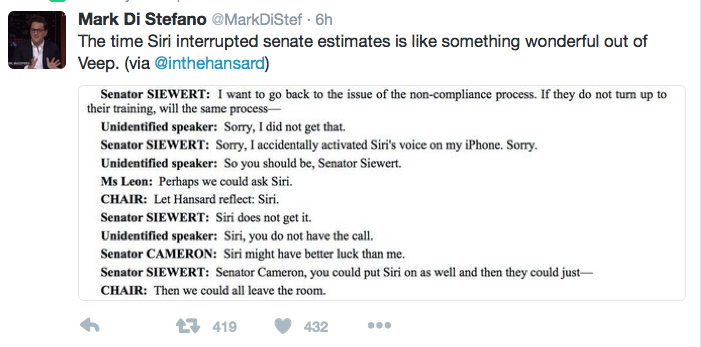May 15, 2016, by Brigitte Nerlich
The ghost in the machine: Of automation, algorithms and AI
 Despite working at the fringes of a field called Science and Technology Studies, I am a bit of a technophobe. I was introduced to computers in the early 1980s and I am still not totally in tune with some of the things they do. To misquote Arthur C. Clarke, most technology, and in particular advanced technology is, to me, indistinguishable from magic.
Despite working at the fringes of a field called Science and Technology Studies, I am a bit of a technophobe. I was introduced to computers in the early 1980s and I am still not totally in tune with some of the things they do. To misquote Arthur C. Clarke, most technology, and in particular advanced technology is, to me, indistinguishable from magic.
Das Kleine Gespenst
This was recently brought home to me when I found a new way of sending relatives in distant parts of the world photos using Google Photos. I also discovered, that I could install an app on my mobile that uploads photos I take directly and automatically to that site. So far so great. But I didn’t expect to get help from ‘an assistant’, i.e. an algorithm with quasi-magical powers. I call it ‘das kleine Gespenst’, after one of my favourite children’s stories (from 1966), by Otfried Preussler. I could also have called it the ‘elves’ after an even older story by the Brothers Grimm, The Elves and the Shoemaker.
Automation magic
Once in a while and quite autonomously, the little ghost turns one of my images into a more stylised image resembling a painting or old photograph (see above) – it “auto creates” them. At other times it adds maps and itineraries to an album, which is quite nice, as I then can actually remember where I was! And on other occasions still, it turns some of my pictures into movies or animations or collages….
When I sent one of these little films to my mother, who had just acquired a magical tablet, she watched one of them and phoned me to say thank you for all the work I had put in to making the photos look like a film, with nice music accompanying the pictures. I had to disabuse her and tell her that this was all done by my little ghost! I had nothing to do with it! Of course I couldn’t really ‘explain’ what was going on there.
When I sent another of these ‘films’ to my sister, made from photos of a graveyard, church, castle and so on, she emailed back to say: “Ok – so the algorithm saw crosses and churchyards and turned the photos into a version of ‘Nosferatu’ from the 1920s or ??? Interesting!”
When I told a student interested in automation and robotics about all this, she told me her story about her robot hoover, loved by her for its cleaning powers and loved by children because they can pet it and watch it move and ‘feed itself’… And I bet you readers have many more such stories you could tell about your own personal pet ghosts and little helpers (and of course little devils too).
To quote the Brothers Grimm: “Then he [the shoemaker] cut his leather out, all ready to make up the next day, meaning to rise early in the morning to his work. His conscience was clear and his heart light amidst all his troubles; so he went peaceably to bed, left all his cares to Heaven, and soon fell asleep. In the morning after he had said his prayers, he sat himself down to his work; when, to his great wonder, there stood the shoes all ready made, upon the table. The good man knew not what to say or think at such an odd thing happening. He looked at the workmanship; there was not one false stitch in the whole job; all was so neat and true, that it was quite a masterpiece.”
A demon haunted world
This was, at least for me the technophobe, an interesting encounter with algorithms, automation and AI, a topic I discuss more abstractly with students in the context of ‘the internet of things’, driver-less cars, fridges that order food etc etc., but had not ‘encountered’ quite so viscerally myself. The question is: Are machine learning algorithms, automation and AI (even AIs in the plural) modern daemons, summoned into our service?! And is it not the case that we almost automatically anthropomorphise what we are not able to understand – indeed we not only anthropomorphise ‘it’, we create mystical and magical creatures to ‘explain’ things to ourselves! We are increasingly living, this time to misquote Carl Sagan, in a demon haunted world of our own making, but one where Sagan’s beloved critical thinking is replaced by magical thinking.
I am of course not the only one musing about all this. In a recent blog post about ‘magical beasts’, Hugh Hancock, a film-maker, games designer, and comics author, says: “Rather than apps, the smart money is now on bots – intelligent servants called and dismissed with specific incantations, capable of granting your heart’s desire (assuming that desire is for an artisanal pizza or an Uber). […] And that led me to thinking. What other roles have humans traditionally attempted to summon, bind, control or conquer supernatural servants for? And to what extent have we managed to replace those with technology?”
PUS and RRI
What does this all mean for public understanding of science and technology or for a topic that is still very much in vogue in Science and Technology Studies and beyond, namely Responsible Research and Innovation? How do we responsibly innovate something we don’t understand, something that, indeed, we do not understand so deeply that we have to resort to fairy tales to be able to live with it?
As Jarno M. Koponen asks in a blog post entitled “The next AI is no AI”: “as the impact of AI technologies increases, the more limited becomes our ability to understand their impact. What does this mean for human agency and the future of artificial intelligence?”
Spirits and Siri
Koponen also says: “Already we trust Spotify recommendations without a glance or talk to Siri and Alexa like they were summoned spirits, intelligences without a tangible form.”
This reminded me of a little story I just (7am, 14 May, 2016) saw on twitter, where Siri piped up during a meeting of the Australian Education and Employment Legislation Committee (6/5/2016, p.29 Senator McKenzie in the Chair) and then made its way into a twitter account called @inthehansard and then trended on twitter (here is the ‘movie’):
No comments yet, fill out a comment to be the first


Leave a Reply